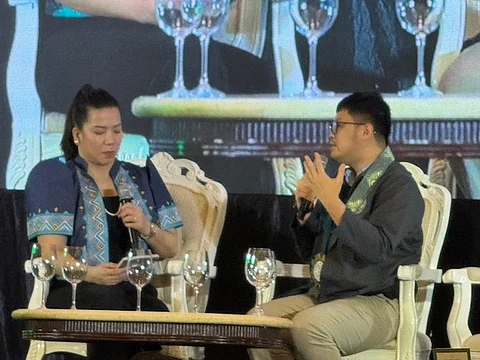
- NEWS
- the EDIT
- COMMENTARY
- BUSINESS
- LIFE
- SHOW
- ACTION
- GLOBAL GOALS
- SNAPS
- DYARYO TIRADA
- MORE

Every day, 12 Filipino women die from cervical cancer — a disease that is both preventable and treatable. At the recent 2025 Cervical Cancer Elimination (CCE) Summit, medical experts, policymakers and advocates rallied behind a bold but achievable goal: To bring the Philippines in line with the World Health Organization’s target of eliminating cervical cancer as a public health problem by 2030.
Held under the theme “One Community Against HPV: Innovations Enabling Cervical Cancer Elimination in the Philippines,” the summit brought together representatives from government, academia, civil society and private sector partners. Their unified message: the tools exist, the data is clear, and the time to act is now.
Global goals, local action
The World Health Organization’s 90-70-90 targets serve as a blueprint for eliminating cervical cancer:
• 90 percent of girls fully vaccinated with the HPV vaccine by age 15
• 70 percent of women screened using a high-performance test by ages 35 and 45
• 90 percent of those with pre-cancer or cancer receiving timely treatment
Meeting these thresholds would drop cervical cancer incidence below the elimination benchmark of four per 100,000 women.
But where does the Philippines stand? While national HPV immunization for young girls has begun, experts agree that coverage remains far too low, public awareness is inconsistent, and screening technologies are unevenly distributed — especially in rural and underserved communities.
AOFOG recommendations: The call to elevate standards
At the heart of the summit were the newly published regional guidelines by the Asia and Oceania Federation of Obstetrics and Gynecology (AOFOG). These emphasize:
• Wider HPV Vaccination Coverage: Not just for girls aged nine to 14, but for both males and females aged nine to 26, with possible expansion up to age 45
• Adoption of the Nonavalent (9vHPV) Vaccine, which offers protection against nine HPV types, including the most dangerous cancer-causing strains
• Inclusive Programs that cover high-risk populations, such as men who have sex with men and immunocompromised individuals
“Science now clearly shows that vaccinating boys not only protects them, but also reduces transmission and strengthens herd immunity,” noted Dr. Kenneth Tse of AOFOG.
Science on the ground: DOST-backed research and local epidemiology
Supporting AOFOG’s call is groundbreaking multi-omics research from UP Manila, funded by the Department of Science and Technology (DOST). Their findings confirm that Filipinas face a broader range of HPV strains than previously accounted for—making the 9vHPV vaccine essential.
Currently, this advanced vaccine is available in private clinics but not yet included in the national immunization program. However, the Health Technology Assessment (HTA) Council is reviewing its adoption for government funding — a major step toward universal access.
“The evidence is overwhelming,” said Dr. Cecilia Padolina, one of the researchers behind the study. “It’s time to update the national HPV strategy based on the real needs of Filipinas.”
Beyond vaccination: Awareness, screening and innovation
The summit also spotlighted the urgent need to combat misinformation. From vaccine hesitancy to myths surrounding HPV, public education must take center stage. Experts urged the launch of nationwide multimedia campaigns to build trust, especially in communities where access to healthcare is limited.
On the diagnostics front, AI-powered screening tools and HPV self-testing kits were presented as cost-effective innovations to improve access and accuracy. These tools are especially valuable in remote areas where women may lack the time or means to visit clinics. “The future of cervical cancer elimination will not rely solely on hospitals,” said Dr. J.B. Torral, a leading OB-GYN oncologist. “It lies in empowering women to take control of their health — at home, in their barangays, and within their own communities.”
Policy alignment and renewed national commitment
Encouragingly, the summit reaffirmed the Philippine government’s policy support through the:
• Universal Healthcare Act
• National Integrated Cancer Control Act
• Philippine Development Plan 2023–2028
• Magna Carta for Women
All of which promote equitable, gender-responsive health services and call for improved prevention and care for diseases affecting women.
The event also revived the AOFOG Manila Declaration, first launched in 2019, as a renewed call for national unity in eliminating cervical cancer through updated policies, community engagement and evidence-based action.
A defining moment
There is a clear pathway forward. The Philippines has the expertise, the community momentum, and increasingly, the scientific tools to achieve cervical cancer elimination within the decade. But it will require collective resolve—from health professionals and educators to parents, local leaders, and government stakeholders.
“The science is here, the policy is catching up, and the people are ready,” concluded Dr. Anna Ong-Lim. “We now have a real chance to end a cancer that has claimed too many lives. Let’s not waste it.”
Key Targets for Cervical Cancer Elimination by 2030
90% of girls vaccinated with HPV vaccine by age 15
70% of women screened by ages 35 and 45
90% of women with pre-cancer or cancer treated
Fast Facts: Why the 9vHPV vaccine matters
• Protects against 9 types of HPV (including those linked to 90% of cervical cancers)
• Recommended by WHO and AOFOG
• Already available in private clinics across the Philippines
• Under review for nationwide rollout through public health programs
At the 2025 Cervical Cancer Elimination Summit, stakeholders from all sectors commit to bold reforms and technological innovation in HPV vaccination and screening—setting the Philippines on the path to elimination by 2030.
